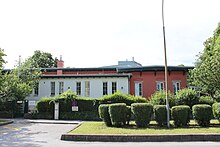Troop Hospital (Wiener Neustadt)
The troop hospital in Wiener Neustadt was used as a military hospital from 1903 to 1918 . The remainder of the hospital is today's Dr.-Paul-Habetin-Kindergarten.
History of the troop hospital as a building
Although an imperial resolution called for the establishment of a military hospital, until 1782 the sick soldiers in the regimental town of Wiener Neustadt were housed in a building outside the fortress town in front of the Ungartor. A fire broke out there in mid-1782, and the sick were quartered in the Pauliner barracks. On July 22, 1782, a warning was issued to the city to start building the military hospital. As a result, the sick were housed in the north far outside the city. Against this, the high and German master regiment lodged a complaint in 1786. The city council then proposed the former Jesuit monastery near the suburban church of St. Leopold as a building, which was approved as a provisional arrangement, but lasted as a provisional arrangement until 1903. After the temporary premises had been cleared, the Wiener Neustadt City Museum was set up there in 1905, and the Wiener Neustadt City Archive was set up in 1992 with a building exchange.
On June 15, 1897, the Wiener Neustadt municipal council decided to build a military hospital. On July 9, 1897, the Neukloster monastery acquired the Schafflerhof at Ungargasse 29. The new troop hospital was designed by the architect Franz Ritter von Gruber with three objects, a main building with a south wing along the Ungargasse and a west wing to the Wiener Neustädter Canal , a morgue and an infection pavilion on the shipping canal. The demolition of the Schafflerhof began on June 17, 1902, and in the same year the shell was brought under the roof and the building project was completed in 1903. On December 2, 1903, the building was handed over to the military by Mayor Franz Kammann and was given the name Kaiser-Franz-Joseph-Truppenspital and was used until 1918 at the end of the First World War . The main building had two sick rooms with 10 beds each and three small doctor's rooms, offices and the hospital kitchen on the mezzanine floor; on the first floor there are two hospital rooms with 10 beds each, 5 hospital rooms, an isolation room, an observation room, an operating room and a roof terrace. All buildings were designed as raw brick construction.
In the inter-war period, the city under Mayor Anton Ofenböck located a youth welfare office , a maternity home with a maternity home and a crèche in the building . Operations began in the summer of 1919. On February 28, 1919, at the request of the local council and ophthalmologist Richard Fröhlich, the local council decided to appoint two school doctors. These school doctors examined the school children and decided on the allocation of children in need of relaxation to the forest school or to other recreational activities in Germany and abroad. A mother counseling center was set up in the youth welfare office, where welfare workers worked with the pediatrician Strauss. On May 14, 1920, through the commitment of Anton Ofenböck and Josef Püchler, a youth welfare home and a crèche for babies were opened in the former military hospital, where orphaned children and toddlers and young people at risk of development were taken in. The child welfare home and the nursery were closed in 1926.
After the " Anschluss of Austria " to Hitler's Germany until 1945 at the end of the Second World War , the Wiener Neustadt military district command was located in the building .
After the war in the summer of 1945, the German district offices became Austrian district authorities again . The Posthof, which had been the seat of the district administration since 1909, was destroyed by bombs during the war, so the district authority Wiener Neustadt was rented in the former military hospital in 1945. On September 29, 1956, the district administration moved into a new office building on Grazer Strasse at the corner of Neuklosterplatz. The former military hospital has now been left to the newly established Austrian Armed Forces as barracks. In September 1956, the newly established Feldjäger Battalion No. 1 in Graz moved into Wiener Neustadt, whose 1st company was billeted until 1958 when it was moved to the renovated infantry barracks. The building was then acquired by the Federal Ministry of Finance, Trade and Reconstruction, Education and the city's commercial schools in Herzog-Leopold-Strasse were relocated to Ungargasse. On January 1, 1961, the school was taken over by the federal government and became the Wiener Neustadt commercial academy and commercial school . The building was expanded in 1964, 1974 and 1981 with additions. After moving the school to the Bechtolsheim barracks for several years, a conversion and renovation was carried out with the architecture office and general planner DELTA - with the main building as a new building - and the school was relocated in 2012.
The local name of the building as a troop hospital changed to Die HAK . The Dr. Paul Habetin Kindergarten is located in the former infection pavilion .
literature
- The “Troop Hospital” (1903) (now a commercial academy). P. 85ff. In: Rudolf Marwan-Schlosser : barracks, soldiers, events. Barracks and military facilities in Wiener Neustadt, Bad Fischau, Wöllersdorf, Katzelsdorf, Felixdorf - Grossmittel - Blumau. Weilburg-Verlag, Wiener Neustadt 1983, ISBN 3-900100098 .
- The health "monitoring" of children. P. 79. In: Walter Edelbauer : Anton Ofenböck. Mayor of Wiener Neustadt from 1918 to 1934. Weilburg Verlag, Wiener Neustadt 1987, ISBN 3-900100-61-6 .
- Manfred Gneist: Memories of an old house. A troop hospital becomes a school. In: Robert Graser, Ruth Plankensteiner (editor): Festschrift on the occasion of the opening of the new building of the Federal Commercial Academy and Federal Commercial School Wiener Neustadt 2012. BHAK / BHAS Wiener Neustadt 2012.
Web links
Coordinates: 47 ° 48 ′ 44.6 ″ N , 16 ° 15 ′ 0.5 ″ E
